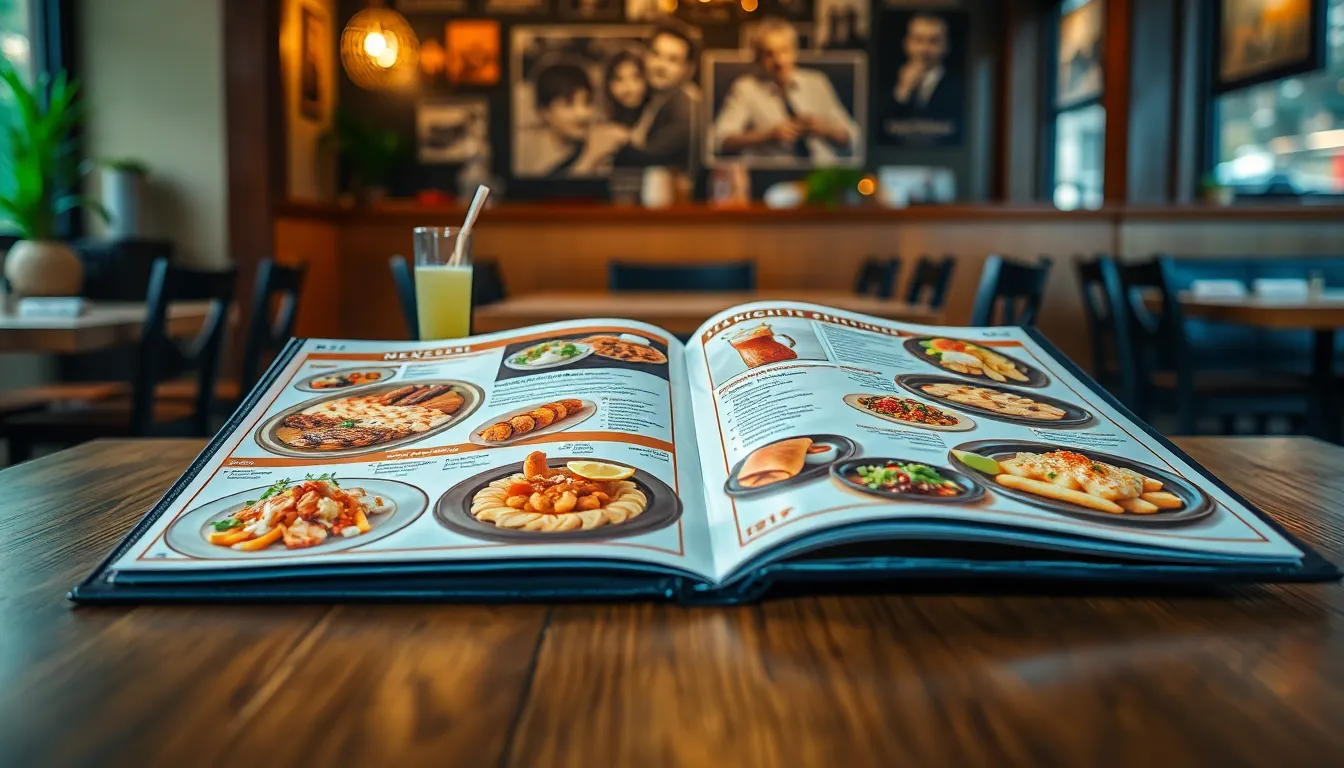Table of Contents
ToggleIn the competitive world of dining, a well-crafted menu can make all the difference. Menu analysis goes beyond just listing dishes; it involves understanding customer preferences, pricing strategies, and culinary trends. By dissecting a menu, restaurateurs can identify strengths and weaknesses, ultimately enhancing the dining experience and boosting profitability.
Effective menu analysis helps businesses adapt to changing tastes and market demands. It reveals which items are popular and which ones might need a refresh. With the right insights, restaurant owners can create a menu that not only delights customers but also maximizes revenue. In this article, we’ll explore the key components of menu analysis and how it can transform a restaurant’s success.
What Is Menu Analysis?
Menu analysis is a strategic process designed to evaluate and enhance a restaurant’s menu offerings. It involves examining customer preferences, pricing tactics, and culinary trends. This evaluation identifies both strengths and weaknesses within the menu, allowing restaurateurs to make informed decisions.
Menu analysis focuses on several key components:
- Customer Preferences: Identifying favorite dishes and seasonal trends helps restaurants tailor their menus more effectively.
- Pricing Strategies: Assessing price points ensures that menu items are competitively priced while maintaining profitability.
- Culinary Trends: Staying updated with current food trends can attract diverse customers and create buzz around new offerings.
By incorporating these components, restaurateurs can adapt to changing market demands, enhance customer satisfaction, and ultimately increase profitability.
Importance Of Menu Analysis

Menu analysis plays a crucial role in optimizing restaurant operations and improving overall business outcomes. It provides valuable insights that help restaurateurs adapt their offerings based on customer behavior and industry trends.
Enhancing Customer Experience
Enhancing customer experience relies on understanding diners’ preferences and expectations. Evaluating menu items allows restaurateurs to highlight popular dishes while removing underperformers. Engaging descriptions and strategic presentation of high-margin items further elevate the dining experience. Additionally, incorporating seasonal ingredients creates freshness and excitement, appealing to customers seeking innovative options. By aligning the menu with customer desires, restaurants foster loyalty and satisfaction.
Increasing Revenue
Increasing revenue hinges on effective pricing and promotion strategies. Through menu analysis, restaurateurs uncover optimal price points and identify high-demand items that maximize profitability. Implementing psychological pricing techniques, such as charm pricing, can entice customers to make purchases. Highlighting special offers or limited-time items drives sales, tapping into urgency and exclusivity. Furthermore, categorizing items into profitable and less profitable segments enables informed decisions about upselling and cross-selling, ultimately boosting overall revenue.
Methods Of Menu Analysis
Menu analysis employs various methods to gain insights into customer preferences and operational effectiveness. These methods facilitate data-driven decisions and enhance overall dining experiences.
Data-Driven Approaches
Data-driven approaches leverage analytics to refine menu offerings. Utilizing sales data, chefs and managers can identify best-selling dishes and track customer trends. By monitoring key performance indicators (KPIs) such as item popularity, average spend per customer, and food cost percentages, restaurants can make informed adjustments. Implementing tools like Menu Engineering, which segments items into categories such as stars, plowhorses, puzzles, and dogs, aids in visualizing a menu’s financial performance.
Visual Menu Analysis
Visual menu analysis focuses on the aesthetic presentation of the menu itself. Analyzing layout, color schemes, and typography helps prioritize high-margin items and guide customer choices. Effective use of images, descriptions, and strategic placement can draw attention to particular dishes, influencing purchasing decisions. Incorporating psychological principles, such as framing attractive dishes at the top or using enticing language, enhances customer engagement and satisfaction. This method not only improves the attractiveness of the menu but also strengthens the overall brand image.
Key Components Of Menu Analysis
Menu analysis comprises several essential components that, when assessed correctly, lead to enhanced customer satisfaction and improved profitability.
Pricing Strategies
Pricing strategies form a crucial part of menu analysis. By assessing price elasticity, restaurants can determine how price changes affect customer demand. Factors to consider include competitor pricing, ingredient costs, and perceived value. Implementing psychological pricing, such as pricing items just below a whole number (e.g., $9.99 instead of $10), often influences customer purchasing decisions. Additionally, analyzing cost-to-price ratios helps in establishing menu item prices that not only cover costs but also contribute to overall profitability. Effective pricing promotes value and encourages trial, ensuring a balanced menu that aligns with customer expectations.
Item Descriptions
Item descriptions significantly influence customer choices. Engaging, descriptive language enhances the appeal of menu items, painting a vivid picture that entices diners. Highlighting key ingredients and unique cooking techniques can create differentiation among similar offerings. Using sensory words that evoke taste, smell, and texture can stimulate customer interest and drive sales. Menu items should also reflect current culinary trends and dietary preferences, such as plant-based options or locally sourced ingredients, which resonate with a growing number of consumers. Effective item descriptions foster a connection between the customer and the dish, enhancing the overall dining experience.
Tools For Effective Menu Analysis
Effective menu analysis relies on various tools that aid in decision-making and enhance restaurant performance. Utilizing the right resources equips restaurateurs to analyze data effectively, leading to improved customer satisfaction and profitability.
- Sales Analytics Software
Sales analytics software tracks real-time sales data, revealing best-selling dishes and trends. This software assists in identifying patterns and making informed decisions about menu offerings.
- Menu Engineering Tools
Menu engineering tools categorize menu items into segments such as stars, puzzles, plowhorses, and dogs. This categorization helps visualize financial performance and prioritize high-margin items.
- Customer Feedback Systems
Customer feedback systems gather insights through surveys and reviews. This feedback informs restaurateurs about diner preferences and helps identify strengths and weaknesses in menu offerings.
- Competitor Analysis Tools
Competitor analysis tools evaluate pricing, menu items, and marketing strategies of competitors. This information aids restaurateurs in aligning their offerings with market demands.
- Visual Menu Design Software
Visual menu design software optimizes the aesthetic presentation of menus. This software analyzes layout, color schemes, and typography, guiding the prioritization of high-margin items.
- Point of Sale (POS) System
A POS system captures detailed transaction data, offering insights into customer purchasing behavior and item popularity. This data streamlines menu adjustments based on real-world performance.
- Dynamic Pricing Tools
Dynamic pricing tools help adjust prices based on demand fluctuations. These tools support revenue management and enable restaurateurs to respond quickly to changes in market conditions.
By leveraging these tools, restaurateurs can conduct comprehensive menu analysis, enabling data-driven decisions and ultimately enhancing the dining experience.
Menu analysis is an essential strategy for any restaurant looking to thrive in a competitive market. By understanding customer preferences and leveraging data-driven insights, restaurateurs can refine their offerings to better meet diner expectations. The right pricing strategies and engaging descriptions can elevate a menu’s appeal while fostering customer loyalty.
Utilizing effective tools for menu analysis empowers restaurant owners to make informed decisions that enhance profitability and optimize operations. This ongoing process not only improves the dining experience but also positions restaurants for long-term success. Embracing menu analysis is a step toward creating a memorable dining atmosphere that resonates with customers and drives business growth.




